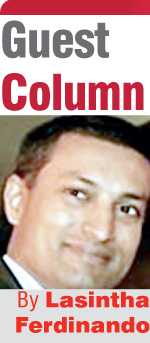Monday Mar 03, 2025
Monday Mar 03, 2025
Thursday, 21 January 2021 00:00 - - {{hitsCtrl.values.hits}}

 Have you ever thought of the cost of information or the research cost to find a solution or a product in the world marketplace?
Have you ever thought of the cost of information or the research cost to find a solution or a product in the world marketplace?
Let’s go back 20 years or even 30 years. To find a buyer or a seller in the world market we used the typical telephone (fixed/land phone) or the fax machine to communicate, and followed by a factory visit or a face-to-face meeting before a business relationship was started. Then there were organisations who used to provide credit or credibility report for a fee or printed publications of manufacturers or the traders or heavily rely on chambers of commerce.
Asian countries used to be colonies of the Western superpowers due to the wealth of natural resources available in the Asian countries but lacked the value addition knowhow (innovation) and the market. Also due to restrictions at the borders for Asian nations to export.
But with the introduction of World Trade Organization (WTO) compliances, it made Asian products to enter Western world under strict rules (Para Tariffs or certifications or rules of origins), but the imports to the Asian countries was made a free flow due to WTO rules enforcement (duty was a taboo). Therefore, although Asian nations were given freedom politically, there were many aspects that the countries were made slaves of the Western world.
One such move was introduction of flat currencies in 1970s scrapping the Gold Standards and the flexible exchange rate enforcement in the Asian countries by the IMF in its fiscal support programs. Only China withstood the forces of the Western world due to their iron fist control of the political environment as well as pegging the currency to the dollar at around 6 Yuan per dollar for a long time.
What China did next was opening the economy for FDIs but with controlling interest retained by the regime of those entities established by the foreign investors. Back then most of the Asian countries were carrying trade deficits to the Western world countries, but the pendulum has changed its course now.
Due to the productivity created in the export oriented entities in China due to the strict exchange rate control, Chinese manufacturers are by far the most cost effective to have them as a supplier to the rest of the world.
There were products entry barrier to China back then. Hong Kong was the stepping stone to access China for premium brands established in the western world. This is how China built enormous foreign reserves by encouraging more exports and restricting imports to that country whilst attracting FDIs in the pretext of an open domestic market in the foreseeable future.
If you dissect the economies of the Western world, it will be obvious that a good part of the economy comprises of service industry and as a result of consumption. As per the table of statistics given below, USA GDP comprise of 80.2% of the services similar to UK, on the contrary China Industry at 40.5% and Services only 51.6%. Amongst the sharks, Sri Lanka stands at 30.5% industry and 61.7% services. 
Furthermore, China is the largest economy in the world for the past so many years at $ 24.2 trillion in PPP terms (Est 2020) although America claims to be the largest economy in terms of nominal terms. This nominal and PPP value differential is as a result of the exchange rate fluctuation.
Now, do you understand the geo politics of the flexible exchange rate and the fiat currency? If I may comment on Sri Lanka, Sri Lanka GDP is 3.5 times higher than the nominal GDP figure and stands at $ 287 billion in PPP terms (Est 2020).
In other words, Sri Lankans are slaves of the Western world, since we need to part with 3.5 times of more resources to satisfy the value of $ 1 worth in the western world. Or Western world receives 3.5 times more satisfaction by just parting with $ 1. Who is the slave now?
Coming back to the topic of the impact of Innovations of the Western world as their own downfall, let’s discuss the internet, emails, cloud solutions, trading platforms such as EBay, Amazon, Alibaba alike.
What happened to JC Penny, Macy’s, Toys’R’Us, Book Stores? What happened to trade accounts of the Western countries? Information super highway made it accessible for information on a click of a button and most of the large orders have disappeared. Small to medium size entrepreneurs provide similar or even superior quality products at a fraction of the cost and services from their living rooms.
The COVID-19 pandemic had made it even to accelerate changes immediately, than what would have taken place maybe in five years to come. So long as the cost of logistics (reliability as well) remain less than the holding cost (hold to deliver), internet platform based businesses will survive.
Now, think of the Service sector based economies where their future employment capable of WFH will shift to Asia more and more due to the price differential and the improved technical capabilities of the Asian country population!
On demand services have become much cheaper (which can be done remotely) and the world is your employment opportunity! Also, the waste and consumption of the Western world reduced since Global Financial Crisis (GFC) created by USA in 2008 and aggravated the status due to COVID-19.
Therefore, the Western world is struggling to keep the economies growing and keep the GDP growth in positive territory quarter on quarter mainly due to drop in consumption in value as well as volume (realisation of availability of cheaper but quality goods out there than what is in stores, buy as you need concept), employment opportunities are supplied by the nations around the world than the host nation.
There is a limit that they (Western world) can invest in infrastructure and induce economic growth. This is witnessed by the lower level of inflation status and such low level of rate of interest on deposits (savings). Interest rates are kept near zero to induce consumption, but how much can you consume as well?
Most of the Western world countries will be another Japan very soon where the deflation is the name of the game. EU region has similar issues with bigger complications to balance 28 countries’ aspirations. No wonder that America is slashing trade tariffs/duty to Chinese products and try to change the economic order! This was a self-inflicted issue by the Americans trying to access a market potential of 1.4 billion people for its products and services.
But China was smarter and had their strategies two steps ahead of the USA and of the rest of the world. Their Belt and Road Initiative (BRI) is a classic example. Their (China) foreign policies are even better by acquiring strategic investments in the rest of the world so that the access to markets as well as making decisions on their own.
We saw that the world economic order was changed by the US predominantly at 40-year time spans such as 1930 introduction of Gold Standard, 1970 fiat currency and the dollar as the Reserve Currency, and in 2008 the GFC followed by quantitative easing which flooded the world with dollars. What’s next? Would it be a cryptocurrency?
As the world trading is taking place on open accounts concept, where dollar dominance can be eliminated. If the world embrace fully in IT trading platforms for global trade and go back to barter system, economic growth of Asian countries are unimaginable with a human resource strength of 2/3 of the world population. If that happens, Sri Lanka will enjoy more goods and services for what we slave now depends on the trustees of resources will act in the interest of the country.
But all these can be changed due to trending so called Artificial Intelligence (AI), going back to trade wars (implementing country specific duty structures. violating WTO standards) and the Media manipulation depends on who is in control! That will be my next article.
(The writer is a business consultant, who had scaled up and revived nine companies/groups in the past six years. He could be reached via email at [email protected].)
Discover Kapruka, the leading online shopping platform in Sri Lanka, where you can conveniently send Gifts and Flowers to your loved ones for any event including Valentine ’s Day. Explore a wide range of popular Shopping Categories on Kapruka, including Toys, Groceries, Electronics, Birthday Cakes, Fruits, Chocolates, Flower Bouquets, Clothing, Watches, Lingerie, Gift Sets and Jewellery. Also if you’re interested in selling with Kapruka, Partner Central by Kapruka is the best solution to start with. Moreover, through Kapruka Global Shop, you can also enjoy the convenience of purchasing products from renowned platforms like Amazon and eBay and have them delivered to Sri Lanka.
Discover Kapruka, the leading online shopping platform in Sri Lanka, where you can conveniently send Gifts and Flowers to your loved ones for any event including Valentine ’s Day. Explore a wide range of popular Shopping Categories on Kapruka, including Toys, Groceries, Electronics, Birthday Cakes, Fruits, Chocolates, Flower Bouquets, Clothing, Watches, Lingerie, Gift Sets and Jewellery. Also if you’re interested in selling with Kapruka, Partner Central by Kapruka is the best solution to start with. Moreover, through Kapruka Global Shop, you can also enjoy the convenience of purchasing products from renowned platforms like Amazon and eBay and have them delivered to Sri Lanka.